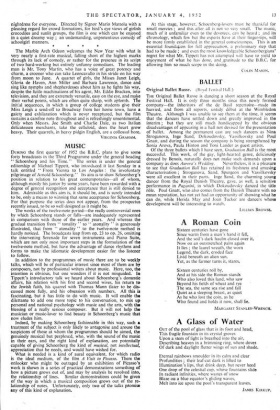DURING the first quarter of 1952 the B.B.C. plans to
give some forty broadcasts in the Third Programme under the general heading " Schoenberg and his Time." The series is under the general editorship of Michael Tippett, who introduced it last Sunday in a talk entitled " From Vienna to Los Angeles : the involuntary pilgrimage of Arnold Schoenberg." Its aim is to show Schoenberg's position in relation to his great contemporaries—all of whom, although mostly his junior by some years, have been rewarded with a degree of general recognition and acceptance that is still denied to him. Admirable as this aim is, it should be, and is surely intended to be, only a means to winning that same acceptance for Schoenberg. For that purpose the series does not appear, from the prospectus recently issued, to be so well designed as it might be.
The works of the twelve-note period—the really controversial ones by which Schoenberg stands or falls—are inadequately represented in comparison with those of the earlier years. And .whereas the gradual transition from " tonality " to " atonality " is generously illustrated, that from " atonality " to the twelve-note method is hardly noticed. The broadcasts leap from op. 23 to op. 26, omitting the intervening Serenade for seven instruments and Piano Suite, which are not only most important steps in the formulation of the twelve-note method, but have the advantage of dance rhythms and forms to make the idiomatic development easier for tho listener to follow.
In addition to the programmes of music there are to be weekly talks, which will be of particular interest since most of them are by composers, not by professional writers about music. Here, too, the intention is obvious, but one wonders if it is not misguided. In Tippett's introductory talk we heard about Schoenberg's domestic affairs, his relation with his first and second wives, his return to the Jewish faith, his quarrel with Thomas Mann (later to be dis- cussed more fully, and his obsession with numbers. All this is fascinating, but it has little to do with music. It will enable the dilettante to add one more topic to his conversation, to mix up personal and national psychology with music and the arts, with the blessing of a really serious composer. But it will not help the musician or music-lover to find beauty in Schoenberg's music that now eludes him.
Indeed, by making Schoenberg fashionable in this way, such a treatment of the subject is only likely to antagonise and arouse the suspicions of those at whom the programmes should be aimed, the genuinely musical but perplexed, who, with the sound of the music in their ears, and the right kind of explanation, are potentially capable of giving Schoenberg the kind of musical, not intellectual, appreciation that he needs, and would have wished for.
What is needed is a kind of aural equivalent, for which radio is the ideal medium, of the film A Visit to Picasso. There the onlooker who might be outraged by an exhibition of Picasso's work is shown in a series of practical demonstrations something of how a picture grows out of, and may by analysis be resolved into, the relationship of lines. Similar demonstrations could be given of the way in which a musical composition grows out of the re- lationship of notes. Unfortunately, only two of the talks piomise any of this kind of explanation. At this stage, however, Schoenberg-lovers must be thankful for small mercies ; and this after all is not so very small. The music, much of it unfamiliar even to the devotees, can be heard ; and its chronology, which few but the experts have at their finger-tips, will be more firmly established in the general consciousness. This is an essential foundation for full appreciation, a preliminary step that had to be made ; and even the most knowledgeable Schoenbergians' regret for what Mr. Tippett has not attempted will have to yield to enjoyment of what he has done, and ,gratitude to the B.B.C. for allowing him so much scope in the doing.
COLIN MASON.






































 Previous page
Previous page